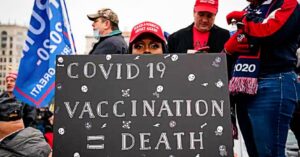In 1944, in his State of the Union speech, President Roosevelt outlined what he called a second Bill of Rights. … That was Roosevelt’s vision 70 years ago. It is my vision today.
—Bernie Sanders, November 2015
The shocking truth is that most democratic socialists and “progressives” who follow Bernie Sanders are just good liberals — FDR liberals to be precise. FDR was the godfather of Democratic liberalism. And that’s still the Democrats’ agenda.
This is terrific news for party unity if it can be widely broadcast.
“Many historians argue that Roosevelt was … the savior of capitalism at a time when socialism could have been an alternative.” Noted socialist Dan La Botz is right about this. FDR saved capitalism and blocked socialism. And most socialists, from the Great Depression on, agree. That’s why I was startled to read that in April 2016 longtime socialist Bernie Sanders visited Roosevelt’s grave, praising FDR as “one of the great, great presidents in the history of our country.”
Sanders didn’t stop there. Four days later, he released a TV/YouTube ad showing him and FDR side by side, telling us that Roosevelt found “a way to break up big banks, create millions of jobs and rebuild America. Some say it can’t be done again. But another native son of New York is ready: Bernie.” Sanders was obviously selling himself as the next FDR.
Now Sanders calls himself both a socialist and a democratic socialist, and he calls FDR’s policy proposals democratic socialism. But none of that matters for the point I’m making now. My point here is simply to agree with Sanders that he has adopted FDR’s policies as his own and sold these to his followers as his political “vision.” The result is:
Sanders’ followers now believe wholeheartedly in FDR’s politics, which is neither “progressivism” nor “democratic socialism” but rather, FDR liberalism, aka Democratic liberalism.
As one more proof of this, consider his famous 2015 Georgetown University speech on democratic socialism. In it, Sanders cited FDR’s 1944 State of the Union address, which he called “one of the most important speeches ever made by a president.” He quoted FDR’s view on economic security and told his audience, “That was Roosevelt’s vision seventy years ago. It is my vision today [emphasis added].”
Was FDR a Socialist or What?
Sanders and his followers have now fully adopted FDR’s political brand. What was it? Before Roosevelt, the term liberalism was used by both Democrats and Republicans to mean something more like “libertarian.” In his “Rugged Individualism” speech of 1928, Herbert Hoover included a short but forceful section advocating liberalism.
Roosevelt knew his New Deal would be attacked as socialistic, so to protect it he called it liberalism — in essence, camouflaging it as part of the conservative tradition. Of course, this upset Hoover and the conservatives, but FDR won that fight, captured the term for the Democrats and redefined it to mean a philosophy of government responsibility for social welfare.
The result was that liberalism came to mean things like unemployment insurance, universal healthcare, Social Security and the like. At the time, this was a radical concept because it went well beyond progressivism. As Roosevelt explained it,
A radical is a man with both feet firmly planted — in the air. A conservative is a man with two perfectly good legs, who, however, has never learned to walk forward. A liberal is a man who uses his legs and hands at the behest of his head.
FDR liberalism took a decisive step in a new and more humane direction, and we are still on that track. However, it is a path that leaves capitalism in place as the economic engine. It’s just a path that humanizes capitalism. FDR considered himself a liberal until his dying day.
Why Did Sanders Turn to Liberalism?
When introducing his version of “democratic socialism” (actually, FDR liberalism), Sanders quoted liberally from FDR’s 1944 State of the Union Message to Congress and relied entirely on its “Second Bill of Rights” for his policy proposals. He cited no other document. So how did he come to focus on this ancient speech?
Take a look at the cover of Cass Sunstein’s book (below), published in 2004. Sunstein was Obama’s regulatory “czar.” And he’s all for a “revolution” to finish implementing FDR’s Second Bill of Rights, just like Bernie. Coincidence?
FDR’s Second Bill of Rights drew attention outside the U.S. for a couple of years after he proposed it in 1944. Then it dropped out of sight for the next 60 years until Sunstein wrote his book, which was reviewed in The New York Times and The Washington Post. In 2006, the book was also reviewed by Thom Hartmann, a prominent left-wing talk-radio host who called it “one of the most important books of this decade.” That review contained a prophetic prediction.
“If a Democratic candidate for the presidency in 2008 were to take up Sunstein’s modern update of Roosevelt’s Second Bill of Rights, he or she would certainly win the election.”
Starting two years before Hartmann’s review, and continuing for a decade, Hartmann hosted Sanders for an hour each week on his Friday morning “Brunch with Bernie” national radio show. Hartmann must have told Bernie about the book with the new ideas that he found so exciting. And because Sanders had long been his favorite potential presidential candidate, he would certainly have told Sanders of his prediction and talked that over with him.
Sunstein (via Hartmann) opened Sanders’ eyes to the notion that he could win the presidency by jumping on FDR’s liberal bandwagon. And if an establishment shill like Sunstein (as Sanders sees him) could call for a revolution right on the cover of his book and still get appointed by Obama, why couldn’t Sanders be just as daring?
In 2019, Sanders doubled down on FDR liberalism by not just promoting it but by following Sunstein’s recommendation of a modern update of Roosevelt’s Bill of Rights. Sanders has now introduced his “21st Century Bill of Rights.” It adds nothing new except the right to a clean environment. (Strangely, it does not add any civil rights.) But this helps him appear, at least to his followers, to be FDR’s true successor.
Are Democrats FDR Liberals Too?
There’s no doubt that Sanders has preached pure FDR liberalism and his followers have bought it, but has the center of the Democratic Party given up on it? Of course, the radicals claim that they have, and this is even one of their central myths.
I think they might not be so sure if they realized that Cass Sunstein, one of Obama’s more moderate appointees, had spent most of a decade researching and writing the book that inspired Sanders’ political “vision” today. And Sanders did not even start talking about this until six years after Sunstein’s book came out. Of course, his “progressives” don’t know this because Sanders has never even mentioned that there is such a book. That would be embarrassing.
So there is a strong theoretical interest in FDR liberalism among Democrats, but that’s not too surprising because FDR is the number-one Democratic hero, practically a saint. If you don’t believe this, you should visit the 7.5-acre FDR Memorial in Washington, D.C., completed in 1995. In my view, it is the most impressive of all the presidential memorials. It was not built by radicals. It’s liberals who have kept the FDR flame alive.
But practically speaking, have Democrats kept the faith? Have they continued to press for the rights FDR listed? I can’t go into all of them, so to avoid any appearance of cherry-picking, I will pick Sanders’ number-one concern, healthcare.
A Short History of the Fight for Healthcare
The radical myth is that liberals turned conservative after 1972 and since then have made no attempt to pass a decent healthcare plan. As it happens, 1972 was the year the radicals’ candidate, George McGovern, lost in a landslide that he correctly characterized as 20 million Democrats leaving the party. After that loss of political power, Democrats scaled back their ambitions and focused on rebuilding the power the radicals had destroyed.
Whose fault was that? As a radical back then, I raise my hand. Nonetheless, in 1976, the Democratic Party platform took this position:
We need a comprehensive national health insurance system with universal and mandatory coverage. Such a national health insurance system should be financed by a combination of employer-employee shared payroll taxes and general tax revenues.
The Democrats had not forgotten. But Carter did not make a strong effort. That upset Ted Kennedy who had, in the late 1960s, dedicated his political career to securing healthcare for all. So the AFL-CIO and the Democratic Party establishment backed Kennedy in challenging Carter, a sitting president. But Carter, not Kennedy, won the nomination and then lost the election.
The Clintons came next. The next opportunity came when Clinton won the presidency in 1992 with only 43% of the popular vote. The first Saturday after his inauguration, he convened a White House healthcare meeting. The effort was led by Hillary and produced a plan for universal healthcare that did not allow insurance companies to discriminate against pre-existing conditions. And the Clintons went after the drug companies:
Exchanging verbal thunderbolts with the companies that make prescription drugs, President Clinton has denounced high prices that force some sick and elderly Americans to skip meals to pay for their medicine.
His proposals for revamping the medical system would fundamentally reshape the playing field for drug companies, pressuring them to hold down prices and in some ways treating them as much like a crucial social service or public utility as private profit-seeking businesses.
—The New York Times, Sept. 30, 1993
The corporations retaliated with about $50 million worth of attack ads. But the failure of the Clintons’ effort can be chalked up to their unwillingness to compromise or even accept a gradual phase-in of universal coverage. Basically, the Clintons had failed because they were still too radical. Remember, they had worked hard for McGovern in 1972.
Obamacare. The Democrats’ next opportunity came with the election of Obama, and he jumped on it immediately. Yes, he offered to work with Republicans. He knew racists, and he wanted to give them no excuses. But that courtesy made no difference to the outcome. In the end, the bill was negotiated solely among Democrats.
Senate Majority Leader Harry Reid had to give up on the public option because of Senators who felt threatened in their relatively conservative states, but they passed a bill with an $800 billion-per-year price tag. Nancy Pelosi and a feminist caucus were forced to give in on abortion for similar reasons. Rahm Emanuel forced the compromise that aligned the two bills — no easy task. And then the Democrats lost the special election for Ted Kennedy’s Senate seat.
Without its expected 60 votes, the Senate couldn’t pass the compromise. Pelosi was forced to start over and get the House to agree to pass the Senate version without any changes. To boost the funding level, she used a tricky “reconciliation” budget bill that only required 50 votes to pass the Senate.
In the end, Reid had no votes to spare in the Senate, and Pelosi had only three spare votes in the House. They squeezed every last drop of progress out of the Congress they had to work with.
At the start of this process, David Axelrod had warned Obama that, given the circumstances, the time might not be right. But Obama thought that if he didn’t act then, it might take another decade. “What are we supposed to do,” he asked, “put my approval rating on the shelf and admire it for eight years?” So he lost his approval rating, and several Congressional members lost their seats, but they did what was right.
We Share the Same Goals
To say the Democratic establishment doesn’t care about the progressive goal of universal healthcare and that they are a bunch of neoliberal shills for the insurance industry is pure slander.
The truth is that progressives and liberals share the same goals of FDR liberalism. The difference is that liberals are willing to compromise to get the ball rolling. That’s the liberal ethic of responsibility discussed in Chapter 18.
The progressives want to stay pure and wait for the revolution. That’s why Sanders would not back Clinton’s health-care proposal. That comes from the dark side of radicalism. But their positive side, the desire for fundamental social change, is fully aligned with FDR liberalism and the Democratic Party. This is what we must focus on to unify the party, beat Trump and keep winning.

 Ripped Apart
Ripped Apart

